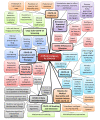Approaches Based on Artificial Intelligence and the Internet of Intelligent Things to Prevent the Spread of COVID-19: Scoping Review
- PMID: 32584780
- PMCID: PMC7423390
- DOI: 10.2196/19104
Approaches Based on Artificial Intelligence and the Internet of Intelligent Things to Prevent the Spread of COVID-19: Scoping Review
Abstract
Background: Artificial intelligence (AI) and the Internet of Intelligent Things (IIoT) are promising technologies to prevent the concerningly rapid spread of coronavirus disease (COVID-19) and to maximize safety during the pandemic. With the exponential increase in the number of COVID-19 patients, it is highly possible that physicians and health care workers will not be able to treat all cases. Thus, computer scientists can contribute to the fight against COVID-19 by introducing more intelligent solutions to achieve rapid control of severe acute respiratory syndrome coronavirus 2 (SARS-CoV-2), the virus that causes the disease.
Objective: The objectives of this review were to analyze the current literature, discuss the applicability of reported ideas for using AI to prevent and control COVID-19, and build a comprehensive view of how current systems may be useful in particular areas. This may be of great help to many health care administrators, computer scientists, and policy makers worldwide.
Methods: We conducted an electronic search of articles in the MEDLINE, Google Scholar, Embase, and Web of Knowledge databases to formulate a comprehensive review that summarizes different categories of the most recently reported AI-based approaches to prevent and control the spread of COVID-19.
Results: Our search identified the 10 most recent AI approaches that were suggested to provide the best solutions for maximizing safety and preventing the spread of COVID-19. These approaches included detection of suspected cases, large-scale screening, monitoring, interactions with experimental therapies, pneumonia screening, use of the IIoT for data and information gathering and integration, resource allocation, predictions, modeling and simulation, and robotics for medical quarantine.
Conclusions: We found few or almost no studies regarding the use of AI to examine COVID-19 interactions with experimental therapies, the use of AI for resource allocation to COVID-19 patients, or the use of AI and the IIoT for COVID-19 data and information gathering/integration. Moreover, the adoption of other approaches, including use of AI for COVID-19 prediction, use of AI for COVID-19 modeling and simulation, and use of AI robotics for medical quarantine, should be further emphasized by researchers because these important approaches lack sufficient numbers of studies. Therefore, we recommend that computer scientists focus on these approaches, which are still not being adequately addressed.
Keywords: COVID-19; SARS-CoV-2; artificial intelligence; internet of things; machine learning; modeling; novel coronavirus; robotics; simulation; telemedicine.
©Aya Sedky Adly, Afnan Sedky Adly, Mahmoud Sedky Adly. Originally published in the Journal of Medical Internet Research (http://www.jmir.org), 10.08.2020.
Conflict of interest statement
Conflicts of Interest: None declared.
Figures
References
-
- Sohrabi C, Alsafi Z, O'Neill N, Khan M, Kerwan A, Al-Jabir A, Iosifidis C, Agha R. World Health Organization declares global emergency: A review of the 2019 novel coronavirus (COVID-19) Int J Surg. 2020 Apr;76:71–76. doi: 10.1016/j.ijsu.2020.02.034. http://europepmc.org/abstract/MED/32112977 - DOI - PMC - PubMed
-
- Long E, Lin H, Liu Z, Wu X, Wang L, Jiang J, An Y, Lin Z, Li X, Chen J, Li J, Cao Q, Wang D, Liu X, Chen W, Liu Y. An artificial intelligence platform for the multihospital collaborative management of congenital cataracts. Nat Biomed Eng. 2017 Jan 30;1(2):0024. doi: 10.1038/s41551-016-0024. - DOI
Publication types
MeSH terms
LinkOut - more resources
Full Text Sources
Miscellaneous



